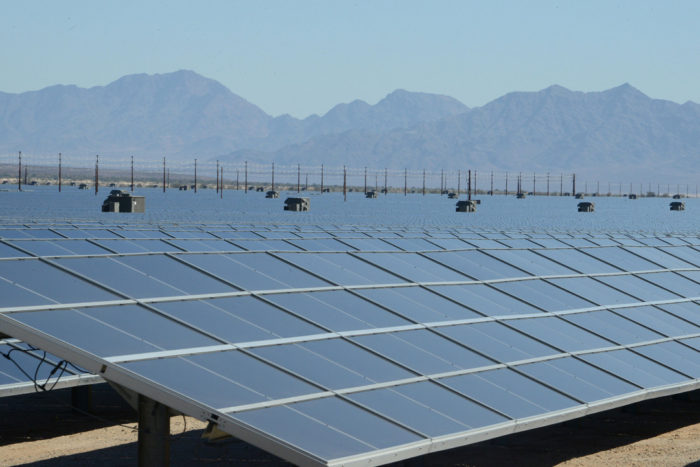
Image Credit: Department of the Interior / CC by SA 2.0 / Flickr
Maine solar farm would be state’s largest
Developers have proposed a solar farm in Sanford, Maine, that would be the state’s largest and one of the biggest in New England.
The Portland Press Herald reports the installation on 226 acres of vacant land at the Sanford Municipal Airport would include 176,000 solar panels and have a rated capacity of 50 megawatts. On a unanimous vote, the Sanford City Council earlier this week endorsed the project and authorized the city manager to sign a lease with Ranger Solar, the Yarmouth, Maine, developer.
Ranger plans to start construction in 2018, but still needs state approval, as well as an endorsement from ISO New England allowing it to connect the panels to the grid.
The biggest solar installation in the state now is a 1.2 MW solar farm on a former Navy air base in Brunswick owned by Bowdoin College. The facility in Sanford would produce enough electricity to power 8,000 homes, The Press Herald said.
Developers plan to build a new transmission line from the airport to an existing substation nearby and sell the electricity through private purchase agreements, the paper said. After construction starts, Ranger will begin paying the city $158,200 per year in rent.
The deal has been under discussion for about three years.
The announcement comes just a week after the Maine Legislature fell a few votes short of overriding a gubernatorial veto of a solar bill that would have significantly expanded the state’s installed solar capacity.
Solar installers, environmentalists, and the state’s investor-owned utilities supported the plan, which would have replaced the current net-metering plan with a novel market-based reimbursement system. But Governor Paul LePage, a Republican, vetoed the bill on the grounds it would increase costs for Mainers who did not own solar panels.
U.S. would forgive eagle deaths
The U.S. Fish and Wildlife Service is once again proposing 30-year permits to wind farms that would allow the deaths of thousands of golden and bald eagles each year without imposing penalties on wind developers, Reuters reports.
A federal judge last year struck down a similar proposal for extending current five-year permits because it didn’t do enough to assess the impact on eagle populations, which are federally protected. In its revised plan, wildlife regulators said the number of bald eagles is going up even as many sectors of the energy industry, including wind, are expanding.
The agency believes the country’s golden eagle population, now at an estimated 40,000, would not be threatened by the loss of about 2,000 birds a year. Bald eagles, now numbering about 143,000, could lose as many as 4,200 birds per year without threatening the population as a whole.
Wind developers have been asking for long-term permits. This new plan is open for public comment through July 5.
Wind farms rather than government regulators would be responsible for keeping track of the “incidental take” of eagles from collisions with turbines and electrical transmission lines, a provision the American Bird Conservancy objected to.
New York to get 241-unit Passivhaus project
Officials in New York City have selected the development team for a 300,000-square-foot mixed use apartment building that would be the city’s largest Passivhaus structure.

The 24-story building, designed by Dattner Architects, will include 241 affordable and moderate-income apartments. On the lower level, it also will include a charter school for children, a grocery store, a medical clinic, and community and cultural spaces, according to a statement from Dattner.
The project, called 425 Grand Concourse, will be built on the site of a public school in the Bronx’s Mott Haven neighborhood and financed by Mayor Bill de Blasio’s 10-year housing plan.
It wasn’t clear when construction would start, or whether developers would seek certification from the Passive House Institute U.S. or the German-based Passivhaus Institut, which use different certification requirements. The cost of the project wasn’t announced.
Apartments will go to tenants who earn between 60% and 100% of the area’s median income, $46,613 to $63,700 for a family of three, according to a post at Politico New York. The building will sit on a 30,000-square-foot city-owned lot.
According to an article posted at Affordable Housing Finance, the project would be the largest Passivhaus structure in the city, although apparently not the tallest. Last year, work started on a 26-story, 270,000-square-foot Passivhaus apartment building on Roosevelt Island, which is between Manhattan and Queens.
That project is part of a new 12-acre Cornell Tech campus and is due for completion next year.
Vertical wind turbines get another look
Wind turbines that spin on a vertical axis have a long history but are derided by most experts as underperforming also-rans, far less efficient than the larger horizontal-axis turbines put to work in utility-scale wind farms.
Research by John Dabiri, an engineering professor at Stanford University, suggests they can be deployed in ways that make them much more productive.
In an article at Forbes, Dabiri says clusters of 10-meter tall vertical-axis turbines can be arranged to take advantage of the air turbulence they create, and can outperform conventional wind farms. And when vertical-axis turbines are placed in wind farms of horizontal turbines, overall production goes up.
According to the article, Dabiri takes a lesson from schools of fish. Swimming in schools, fish benefit from turbulence in the water, so much so that even a dead fish is carried along by the rest of the group. Wind farm operators have used this principle to get the most out of conventional turbines, and Dabiri says that placing small vertical-axis turbines in the spaces between the larger turbines reduces turbulence and improves the farm’s efficiency. Less turbulence also increases the life span of horizontal-axis turbines.
In a study published in Wind Energy, researchers simulated the addition of small, vertical-axis turbines in a field of conventional horizontal-axis turbines and found the farm would be able to produce as much as 32% more electricity, with the power output of the large turbines increasing by 10%, Forbes said.
“Of all the companies that are out there operating these, there have been no reported bird or bat strikes,” Dabiri said. “This is for two reasons: one, of course, they’re closer to the ground so they’re not going to be necessarily in the flight corridor. But they also have this rotation around a vertical axis which has a very different visual signature than the very fast moving blades of a conventional wind turbine.”
Dabiri says the simpler vertical-axis turbines, with many fewer moving parts, should last longer and have lower operating costs. But he was quick to add savings haven’t been proven in the field, and startup companies making vertical-axis machines are still working out the bugs in their designs.
“There are a couple of companies that are close to having something that I would recommend to my parents to buy—that’s the metric that I use—but they’re not quite there yet,” he told Forbes. “So there is still work to be done in terms of the reliability required, especially when you’re making so many of them.”
Weekly Newsletter
Get building science and energy efficiency advice, plus special offers, in your inbox.














0 Comments
Log in or create an account to post a comment.
Sign up Log in